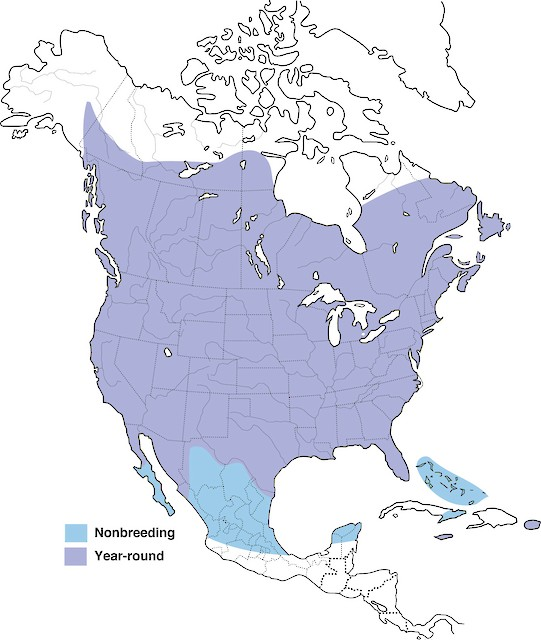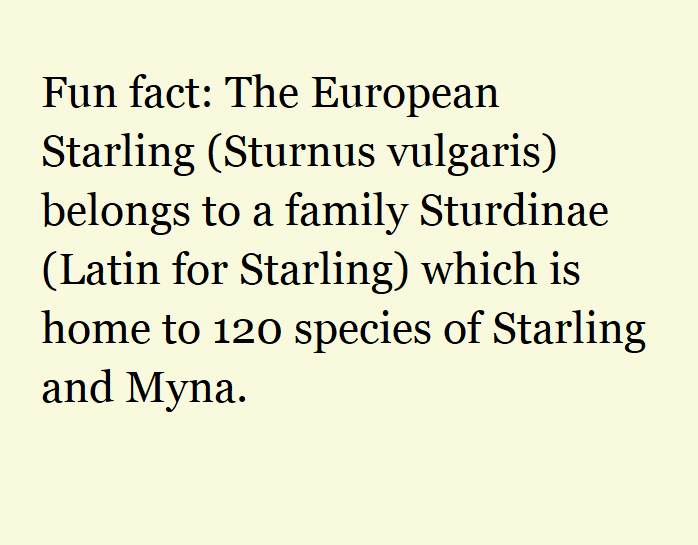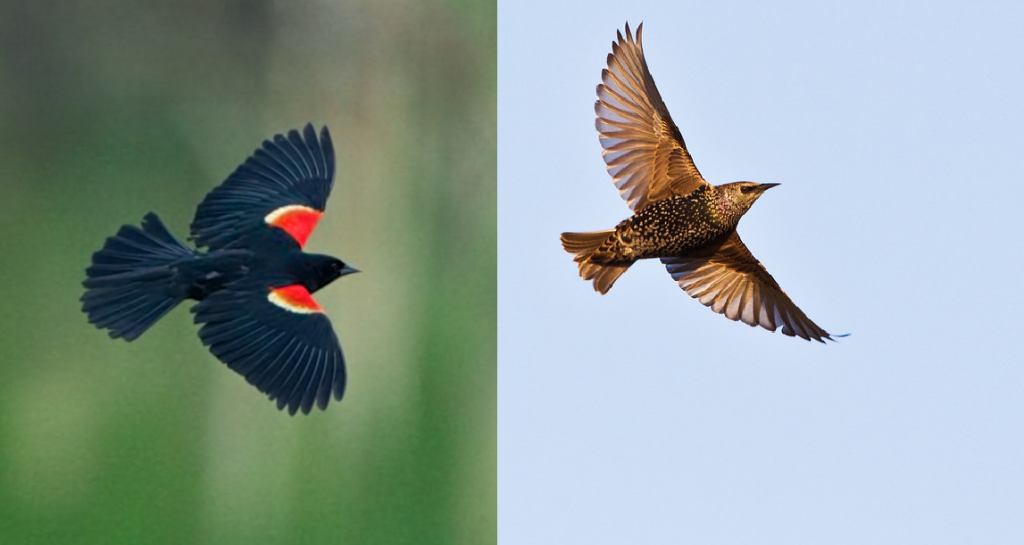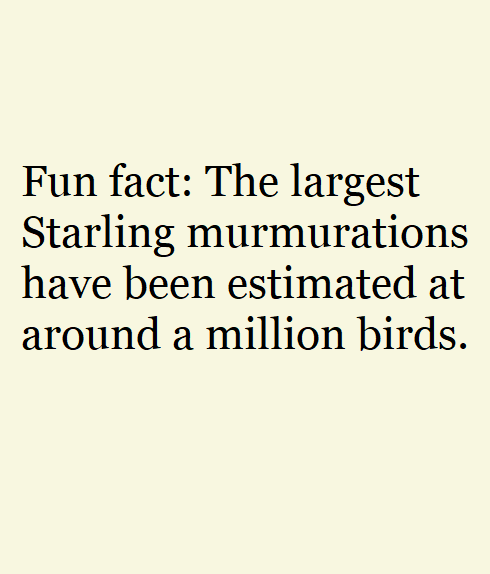The year was 1890, Europeans flocked to the big apple for a chance to begin a better life in the new world. Bringing with them shoes, hats, smallpox, and the European Starling.

As the legend has it, an avid Shakespeare fan, and lover of birds, by the name of Eugene Schieffelin introduced 60 Starlings to Central Park New York City with the dignified intent of introducing all species of bird mentioned in Shakespeare’s writings (Zielinski 2011). The Nightingales and the Skylarks he had previously released had all died off, so he could only cross his fingers and hope that the Starlings would breed (Zielinski 2011)! And indeed, breed they did. Today, 129 years later, North America is home to over 200 million Starling ranging geographically from Alaska all the way down to central America (Cabe 1993). Thanks Eugene!

Meet The European Starling
Starling’s are moderate sized passerine bird that is very similar in size to an American Robin; the average European Starling has a 16 inch wing span, is about 8 and a half inches long, and weighs in at 82 grams (Sibley 2000). If you are looking to spot a European Starling the first thing you need to know is that they have differing plumages throughout their life.

In breeding season (between spring and summer) the European Starling is very striking. A mysterious colour palette of iridescent deep purples, blues, and greens accompanied by a distinguishable yellow bill combine to give this bird a sinister beauty — sinister because they are horribly invasive, and beauty because they are quite beautiful (Sialis 2016; The Cornell Lab… 2019). In non-breeding season the bill will usually be black but will turn yellow as breeding season grows near and the colours of the plumage are the same. However, you will be able to see cream coloured spots speckled about their body. This is because when their feathers are first grown they have cream tips (The Cornell Lab… 2019).

By breeding season all these spots will be gone, but not by molting as you might have suspected. Instead, the spots disappear by simply being worn off (Sibley 2016). The feathers do not continue to wear down past the tips as the rest of the feather contains melanin (a dark pigment that is resistant to wear). Finally, in juvenile plumage the Starling will be a pale brown colour with no spots at all and a black bill (Sibley 2016).
For further identification traits it is helpful to know that they tend to fly in flocks — known as murmurations, but more on that below— and their flight pattern is a sustainable powered flight with very little gliding (Sialis 2016). A wise Frenchmen once told me that the European Starling is easily identifiable by its short tail and its pointed wing tips (2019 advice from Eric Demers)… Moments later he confused a Raven for an Eagle, but that’s beside the point.

European Starling’s don’t like to eat alone, they primarily feed on insects and prefer to forage on the ground but may also feed in flight (Audubon 2019). Skull and jaw muscle adaptations have been noted to allow the bird to spring its mouth open to help with probing and feeding. Upon inserting their bill into the soil the European Starling’s strong jaw muscles allow it to spring open and widen the hole (The Cornell Lab… 2019). Furthermore, their narrow skull makes it possible for the eye to move forward allowing the European Starling to peer into the hole and identify any food items (Sialis 2016).
While the European Starling seems to prefer feeding on insects, they are very versatile and adaptive feeders; a skill that has no doubt helped them become so established world wide (Sialis 2016; Audubon 2019; The Cornell Lab… 2019). They have been documented to eat fruits, insects, spiders, snails, seeds, and even frogs and lizards (Sialis 2016 ). Considering just how far and wide this bird has travelled it should come as no surprise that they eat such a cultured diet.
Because of this diet the European Starling has been referred to as a pest by many. These guys might just come along and dig up your newly planted seeds, or maybe they’ve decided to eat your grapes right off the vine. Either way, when a large group of Starling come around your crops you could find yourself faced with a lot of damage. A 1996 study estimated that European Starlings caused 800 million dollars of agricultural damage per year in the United States alone (Pimental et al. 2000).
On top of being an agricultural pest, the European Starling is also a pest to native bird species. European Starlings tend to be particular about their nesting sites, preferring to nest in pre-established cavities (The Cornell Lab… 2019). Well what happens if they like the nesting nook of another bird? Unfortunately, they have been known to evict many native species from their nesting sites, including: Wood ducks, Woodpeckers, Screech Owls, Kestrel, and undoubtedly many more (Sialis 2016). European Starlings even tend to torment their kin, up to one third of a European Starling’s first broods are killed by fellow Starlings dumping eggs out of the nest (Sialis 2016).
While we deem the Starling to be a bit of a pest it seems that they enjoy being around us as they are most often found in disturbed habitat such as suburbs, fields, and farms and are rarely seen in extensive forests. Some European Starling may migrate for a warmer climate in the winter, yet others choose not too (Sialis 2016). As can be seen in figure 1, they are found year-round in almost all of North America.
The European Starling has been known to dabble in vocal mimicry and is classified as an intermediate mimic meaning it does mimic but predominately uses its own vocalizations (Hindmarsh 1984). While the European Starling can mimic, their repertoire is limited to songs and sounds that are simple in structure but they can still learn dozens of different songs (Hindmarsh 1984). As with many mimics, these mimicked vocalizations are used as a breeding strategy by males for attracting a female. However, both males and females can mimic and are known to sing outside of breeding season (Sialis 2016).
A Murmuration Of Starling
Flocks of birds all have bizarre names… I encourage you to check out this list if you are looking for some quality procrastination! A flock of Starling is known as a murmuration. Murmurations can be breath taking and fascinating to observe. Like a perfect sunset it’s almost impossible for a photo or video to do this phenomenon justice. The movement that is sometimes displayed during a murmuration is simply astounding, it’s almost as if the birds are one hive-mind entity. The exact reason why Starling’s participate in murmurations isn’t fully understood, but there are some leading hypotheses — before we go any further let’s take a look at a murmuration!
Obligatory “that’s pretty neat!”
Have you ever heard the expression “You don’t have to outrun a bear. You only have to outrun your slowest friend”? Well, that expression just might hold true when it comes to starlings. Some researchers propose European Starlings may use murmurations to ‘dilute’ themselves into a flock and lower their chances of being snatched up by avian predators such as falcons and hawks (Goodenough et al. 2017). Okay so maybe this is the reason large groups of European Starling come together, but you might be wondering why they act out such eerie undulations. Of course, researcher’s have a hypothesis for that — the “selfish herd” theory.
The selfish herd theory suggests that the individual Starlings may be trying to avoid the edge of the murmuration, where they are most susceptible to predation, by moving towards the centre (Goodenough et al. 2017). Since all birds are constantly trying to ‘out-run-their-friend’ to the centre it results in a dynamic centre that is constantly shifting and moving around.
There’s also strong reason to believe that the murmurations might exist to confuse predators (Procaccini et al. 2011; Goodenough et al. 2017). The constant wave-like motions of the flock may be interfering with a predator’s ability to lock onto a target. One study showed that these wave-like movements occurred much more frequently while under predation and that the waves propagated away from the predator. In this sense it’s almost as if the predator is the source of the wave (Procaccini et al. 2011).
The question scientists can’t help but ask is “how exactly are these birds communicating and moving in unison?” An interesting study by an Italian theoretical physicist focused on how the communication during murmuration can be explained by “self-organized criticality” which is the same principal behind how an avalanche occurs (Cavagna et al. 2010)! In the simplest of terms self-organized criticality is a property of dynamic systems that have a critical point. Think of it like having a pile of sand and each additional grain of sand you drop on top causes a small avalanche of sand (Self-organized… 2018). Now if we think of the dynamic system that is a starling murmuration, we can imagine that first bird to move in response to an environmental influence is the grain of sand that causes an avalanche. A starling moves and all nearby starlings follow suit causing a cascade of movement! On top of that mathematical analyses shows that all Starling’s in a flock are influenced by one another no matter how far apart they are and no matter how big the flock is (Cavagna et al. 2010). Still, these are birds we are talking about, not just grains of sand. It is quite frankly nothing short of incredible that they are able to achieve this level of connection.

Akin to a well-trained scouts’ troop, the European Starling murmuration move as a well-organized group. The shape of the flock is almost always guaranteed to follow the same proportions and aspect ratio regardless of the size of the group (Ballerini et al. 2008). The murmurations are often thin and elongated and while this shape is well documented there is no consensus as to why this shape is adopted. It could be due to several factors including aerodynamics and even gravity making thin and wide flocks more favourable (Ballerini et al. 2008)! Murmuration dynamics have been studied from a physics, mathematics, and biological point of view for many years and continue to fascinate scientists from all fields with their extraordinary complexity.
Tell me, where can I see this phenomenon?
Well I am glad you asked!
If you are looking to see a murmuration in person you will have the best chance by going to an area where European Starling are common such as fields and other disturbed areas. Seasonally European Starlings are known to have the largest murmurations in winter when more birds are in closer geographical proximity due to flocking to warmer climates — however, I have found that downtown Nanaimo during the summer months can be a great place to witness some awesome murmurations!
The European Starling is a polarizing bird. Striking in image and mesmerizing in murmuration, yet they are an invasive species that has impacts on native ecosystems. Fortunately, they haven’t appeared to contribute the declines of most native bird populations so don’t feel too guilty next time you are kicking back to ‘chillax’ and enjoy a murmuration (The Cornell Lab… 2019).
All about birds [Internet]. 2019. The cornell lab of ornithology: [cited 2019 oct 24]. Available from: https://www.allaboutbirds.org/guide/European_Starling/lifehistory.
All about starlings [Internet]. 2016. Sialis: [2019 oct 24]. Available from: http://www.sialis.org/starlingbio.htm.
Ballerini M, Cabibbo N, Candelier R, Cavagna A, Cisbani E, Giardina I, Orlandi A, Parisi G, Procaccini A, Viale M, et al. 2008. Empirical investigation of starling flocks: a benchmark study in collective animal behaviour. Anim Behav. 76(1): 201–215. Available from: https://www.sciencedirect.com/science/article/pii/S0003347208001176
Cabe PR. 1993. European Starling (Sturnus vulgaris). The Cornell Laboratory of Ornithology. Available from: https://birdsna.org/Species-Account/bna/species/eursta/introduction.
Cavagna A, Cimarelli A, Giardina I, Parisi G, Santagati R, Stefanini F, Viale M. 2010. Scale-free correlations in starling flocks. Proc Natl Acad Sci U S A. 107(26): 11865–11870. Available from: https://www.pnas.org/content/107/26/11865/
European Starling [Internet]. 2019. Audubon; [cited 2019 oct 24]. Available from: https://www.audubon.org/field-guide/bird/european-starling
Goodenough AE, Little N, Carpenter WS, Hart AG. 2017. Birds of a feather flock together: Insights into starling murmuration behaviour revealed using citizen science. PLoS One. 12(6): 1–18. Available from: https://journals.plos.org/plosone/article?id=10.1371/journal.pone.0179277
Hindmarsh AM. 1984. Vocal mimicry in starlings. Behaviour. 90(4), 302-324. Available from : https://www.jstor.org/stable/4534373?seq=1#metadata_info_tab_contents
Inger R, Gregory R, Duffy JP, Stott I, Voříšek P, Gaston KJ. 2015. Common European birds are declining rapidly while less abundant species’ numbers are rising. Ecol Lett. 18(1): 28–36. Available from: https://onlinelibrary.wiley.com/doi/abs/10.1111/ele.12387
Pimental D, Lach L, Zuniga R, Morrison D. 2000. Environmental and economic costs of nonindigenous species in the united states. Bioscience. 50(1): 53. Available from: https://bioone.org/journals/BioScience/volume-50/issue-1/0006-3568(2000)050[0053:EAECON]2.3.CO;2/Environmental-and-Economic-Costs-of-Nonindigenous-Species-in-the-United/10.1641/0006-3568(2000)050[0053:EAECON]2.3.CO;2.short
Procaccini A, Orlandi A, Cavagna A, Giardina I, Zoratto F, Santucci D, Chiarotti F, Hemelrijk CK, Alleva E, Parisi G, et al. 2011. Propagating waves in starling, Sturnus vulgaris, flocks under predation. Anim Behav. 82(4): 759–765. Available from: https://www.sciencedirect.com/science/article/pii/S0003347211002867
Self-organized criticality explained [Internet]. 2018. Everything explained today: [cited 2019 oct 24]. Available from: https://everything.explained.today/Self-organized_criticality/
Sibley DA. 2016 Sibley Birds West. Second edition. New York (NY): Alfred A. Knopf. 477 p.
Zielinski S. [Internet]. 2011. The invasive species we can blame on shakespeare. Smithsonianmag.com [updated 2011 oct 4; cited 2019 oct 24]. Available from: https://www.smithsonianmag.com/science-nature/the-invasive-species-we-can-blame-on-shakespeare-95506437/.
Hi Joel,
What a wonderful and engaging blog! You keep the reader hooked right to the end with all your fun facts and hidden jokes (I always love getting advice from “wise” OLD Frenchmen). I loved your use of effective visuals to illustrate the different plumages we see throughout the year and to compare the Red-Winged Blackbird and European Starling in flight. Plus your video of the murmuration was really neat — reminds me that sometimes math CAN be cool!
I had no idea how much damage Starlings are capable of… 800 million dollars of yearly agricultural damage is a lot! These birds are just all around annoying – but I would still love to see one in the hand (although I’ve heard they have the absolute nastiest excrements for a songbird)!
You mention in your not-so-fun fact that the European Starling has been introduced with a purpose in other places. Do you know if they are as destructive in New Zealand, Australia, Fiji, South Africa, etc. as they are in North America? Or are less less successful there?
Also, I loved the link to to the names of flocks of birds (I am a sucker for quality procrastination). My favourite ones in there are a whirligig of Phalaropes and a crookedness of Crossbills!
Thanks for an excellent and compelling blog, and great job!
Sam
Hi Sam,
Thank you for the kind words I am glad you enjoyed reading the blog!
I have also heard their excrements can be nasty, and that doesn’t account for the sheer volume of excrement a large murmuration may be ‘raining’ down on anything or anyone unlucky enough to be below.
It appears the European Starling’s most successful habitat globally is North America where approximately 33% of the global population can be found. Interestingly, in Australia they haven’t been able to go further north than Brisbane, which means they only occupy ¼ of the country despite being introduced 40 years earlier (Linz 2007).
The European Starling occupies all of New Zealand and in an ironic twist agriculturists over there actually welcome the bird as it does less damage to crops than some of the native insect pests that they snack on (Starling 2014).
It is tricky to find good data for the other places where the EUST is found but an interesting tidbit I did stumble upon is how the European Starling has been helping another invasive species thrive in Bermuda. The fruits of the invasive Brazilian Pepper tree are commonly distributed to nearby islands by the EUST. For many of these islands the Pepper tree is being introduced or reintroduced as efforts have been made to eradicate the tree from the island nations (Mack 2002).
Personally, I am partial to a convocation of Eagles 😉
Thanks again!
Joel
Linz GM, Homan HJ, Gaulker SM, Penry LB, Bleier WJ. 2007. European starlings: a review of an invasive species with far-reaching impacts. Managing vertebrate invasive species. 24: 378-386. Available from: http://digitalcommons.unl.edu/cgi/viewcontent.cgi?article=1023&context=nwrcinvasive
Mack RN, Lonsdale WM. 2002. Eradicating invasive plants: hard-won lessons for islands. Turning the tide: the eradication of invasive species. 1(1): 164-172. Available from: https://portals.iucn.org/library/sites/library/files/documents/SSC-OP-028.pdf
Starling [Internet]. 2014. NZbirds: [cited 2019 oct 24]. Available from: https://www.nzbirds.com/birds/starlings.html
Hey Joel,
Super engaging blog!! You had me hooked the entire time! I found it really interesting that their cream coloured spots during non-breeding season actually just wear down over time instead of moulting. I didn’t know that that happened and find it really cool that the melanin results in such great protection.
Kind of random question but you mentioned that there are less European Starling’s in Europe than in North America and I was just wondering whether anything is being done in Europe to help with the conservation of these birds or whether they aren’t really showing concern because they are doing so well elsewhere??
Once again, thanks for the super cool blog! Loved all of the images and the video of the murmuration!!
Danielle
Thanks for the comment Danielle!
I’m glad you enjoyed reading the blog. It is crazy to think that a microscopic pigment makes such a big difference in feather wear! That was something that also really amazed me when I was doing research on the EUST.
Great question! While I didn’t elaborate this in my blog, European Starling are declining at a significant clip in many areas of Europe. The British Trust for Ornithology (BTO) cites a 66% decline since the 1970s and lists them as high conservation concern (Royal Society… 2018). Crazy to think how differently we view these birds over here.
Europeans (the English mainly) seem to be quite fond of the European Starling due to their cultural significance in many of Shakespeare’s writings and they are very concerned about their declining numbers (The Guardian 2012). Their declining numbers in the UK are thought to be largely due to loss of grasslands (as they become converted into forestry and agricultural lands) and the decline of insects due to pesticides, but experts aren’t certain if these are the only causes (Bruun 2003). The encouragement of farmers to make use of field margins — a metre or so wide strip between crops and surrounding environment to benefit wildlife — is one strategy that is important for European Starling conservation, although this strategy is not employed specifically for the EUST (Bruun 2003).
I did not come across any information about providing nest boxes for the Starlings.
Thanks Again!
Joel
Bruun M, Smith HG. 2003 Landscape composition affects habitat use and foraging flight distances in breeding european starlings. Biol Conserv. 114 (2): 179-187. Available from: https://www.sciencedirect.com/science/article/abs/pii/S0006320703000211
Garden Starlings in 79% UK decline [Internet]. 2012. The Guardian: [cited 2019 nov 20]. Available from: https://www.theguardian.com/environment/2012/mar/29/starlings-uk-gardens-decline-rspb
Population trends and conservation [Internet]. 2018. Royal Society for the Protection of Birds: [cited 2019 nov 20]. Available from: https://www.rspb.org.uk/birds-and-wildlife/wildlife-guides/bird-a-z/starling/population-trends-conservation/
Hi Joel,
Very cool blog! You changed my perspective on these very interesting birds that are mostly dismissed as pests.
As for the murmuration section, you mentioned that they may flock together to avoid predation and that the largest murmurations have been estimated at around 1 million individuals. There was SO many in your video, it seems like that many would deplete food resources quickly and not be very beneficial when there’s that many individuals. Does this happen and do the starlings move around frequently in order to constantly gain new food sources?
Thanks for Reading Olivia!
They are a pretty cool bird it’s too bad they can be so destructive sometimes :/
Wow great question!
Unfortunately, I couldn’t find any data about how frequently they forage in one place or the impacts they have on insect populations, but as I mentioned in my blog they cause a lot of crop damage every year by feeding excessively on the fruit or digging up seed so it seems that if the food source is reliable enough than they will exploit it (Pimental et al. 2000).
Often the EUST form murmurations at dusk just before they roost for the night. It is more common for their feeding to be done in smaller groups during the day (Goodenough 2017). These smaller groups obviously won’t have as dramatic of an impact on the available food source.
It’s important to keep in mind just how diverse the diet of a European Starling can be… They can eat essentially any insect they come across, and they will eat some annelids and other invertebrate prey as well as frogs and lizards on occasion (Sialis 2016)! If that wasn’t diverse enough, we also must consider that they eat fruits, seeds, nectar, and grain (Sialis 2016) My parents would have loved it if they could get me to eat a diet this diverse as a kid!
I wish I could do your question justice with a more in-depth answer because it is an interesting angle to consider when thinking about large populations of animals feeding.
Thanks,
Joel
All about starlings [Internet]. 2016. Sialis: [2019 oct 24]. Available from: http://www.sialis.org/starlingbio.htm.
Goodenough AE, Little N, Carpenter WS, Hart AG. 2017. Birds of a feather flock together: Insights into starling murmuration behaviour revealed using citizen science. PLoS One. 12(6): 1–18. Available from: https://journals.plos.org/plosone/article?id=10.1371/journal.pone.0179277
Pimental D, Lach L, Zuniga R, Morrison D. 2000. Environmental and economic costs of nonindigenous species in the united states. Bioscience. 50(1): 53. Available from: https://bioone.org/journals/BioScience/volume-50/issue-1/0006-3568(2000)050%5B0053:EAECON%5D2.3.CO;2/Environmental-and-Economic-Costs-of-Nonindigenous-Species-in-the-United/10.1641/0006-3568(2000)050%5B0053:EAECON%5D2.3.CO;2.short